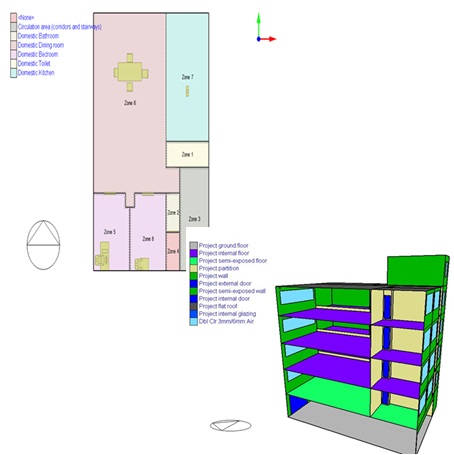The Effect of Employing a Thermal Insulation Layer in the Building Façade on Energy Consumption (A case study of a residential building in Tehran)
The Effect of Employing a Thermal Insulation Layer in the Building Façade on Energy Consumption
DOI:
https://doi.org/10.61186/7.3.29Keywords:
Energy Consumption, Design Builder Software, Façade, Thermal Insulation, Residential BuildingAbstract
Although currently, a large part of the existing buildings are considered inefficient in terms of energy, the ability to save energy consumption up to 80% has been proven in residential and commercial buildings. This study aims to calculate energy consumption during the operational phase caused by various scenarios of thermal insulation combinations in a building's exterior shell. The simulation was conducted using Design Builder software, with a five-story residential building in Tehran as the case study. Initially, the building was modeled in Design Builder, and keeping all other characteristics constant, ten scenarios were defined: nine using different types of thermal insulation and one without insulation. The software outputs for each scenario were analyzed. Results showed that the best thermal insulation layer is polyurethane foam, which saves 1070.15 kilowatt-hours of energy during one year of the building's operation. This article can help designers and construction engineers optimize the energy consumption of buildings by deciding the right materials. © 2017 Journals-Researchers. All rights reserved
References
[1] Azizkhani, M., A. Vakili, Y. Noorollahi, and F. Naseri. “Potential survey of photovoltaic power plants using Analytical Hierarchy Process (AHP) method in Iran.” Renewable and Sustainable Energy Reviews 75 (2017): 1198–1206. https://doi.org/10.1016/j.rser.2016.11.103
[2] Ramakrishnan, S., X. Wang, J. Sanjayan, and J. Wilson. “Thermal performance of buildings integrated with phase change materials to reduce heat stress risks during extreme heatwave events.” Applied Energy 194 (2017): 410–421. https://doi.org/10.1016/j.apenergy.2016.04.084
[3] Navayi, A. M., A. F. Jouzayi, A. Ghafouri, and M. M. Adeli. “The effect of using air gap in the walls on reducing the energy consumption of a residential building.” New Practice and Computer Findings in Mechanics and Systems (2023). https://civilica.com/doc/2053356
[4] Soltani, M. and A. Atashi. “Second Skin of Facade Impact on Office Building Life Cycle Energy Consumption: A Comparative Study.” International Journal of Architectonic, Spatial, and Environmental Design 18.1 (2024).
[5] Feehan, A., H. Nagpal, A. Marvuglia, and J. Gallagher. “Adopting an integrated building energy simulation and life cycle assessment framework for the optimisation of facades and fenestration in building envelopes.” Journal of Building Engineering 43 (2021): 103138. https://doi.org/10.1016/j.jobe.2021.103138
[6] Ustaoglu, A., A. Yaras, M. Sutcu, and O. Gencel. “Investigation of the residential building having novel environment-friendly construction materials with enhanced energy performance in diverse climate regions: Cost-efficient, low-energy and low-carbon emission.” Journal of Building Engineering 43 (2021): 102617. https://doi.org/10.1016/j.jobe.2021.102617
[7] Pedroso, M., J. de Brito, J. D. Silvestre, and V. M. Ferreira. “Characterisation of a multilayer external wall thermal insulation system. Application in a Mediterranean climate.” Journal of Building Engineering 30 (2020): 101265. https://doi.org/10.1016/j.jobe.2020.101265
[8] Mahmoud, S., M. Fahmy, M. Mahdy, I. Elwy, and M. Abdelalim. “Comparative energy performance simulation for passive and conventional design: A case study in Cairo, Egypt.” Energy Reports 6 (2020): 699–704. https://doi.org/10.1016/j.egyr.2019.09.052
[9] Mirrashid, N. and L. Mirsaeedie. “The Effect of Thrombus Wall System on Thermal Comfort in Temperate and Humid Climates (Case study of a residential building in Gonbad Kavous).” (2020).
[10] Fathalian, A. and H. Kargarsharifabad. “Investigating the effect of different energy saving strategies on energy rating of building by design builder software (case study: office building).” (2020).
[11] Toosi, Golnoosh. “Influence of Vegetation in The Flood Drainage Ditch.” Journal of Civil Engineering Researchers 5.4 (2023): 16–21. https://doi.org/10.61186/JCER.5.4.16
[12] Alimohammadi, Hossein and Ashfaq A. Memon. “Case Study of Mechanically Stabilized Earth (MSE) Retaining Wall Failure in the State of Tennessee; Recommendations for Future Design and Constructions.” Journal of Civil Engineering Researchers 5.1 (2023): 52–65. https://doi.org/10.61186/JCER.5.1.52
[13] Oliaei, Mohammadreza, Mahdi Mashhadiyan, and Reza Forootan. “Seismic Performance Evaluation of Friction Damper and Yielding Metallic Damper in Steel Frame.” Journal of Civil Engineering Researchers 5.3 (2023): 1–14. https://doi.org/10.61186/JCER.5.3.1

Downloads
Published
Issue
Section
License
Copyright (c) 2025 Journal of Civil Engineering Researchers

This work is licensed under a Creative Commons Attribution 4.0 International License.




